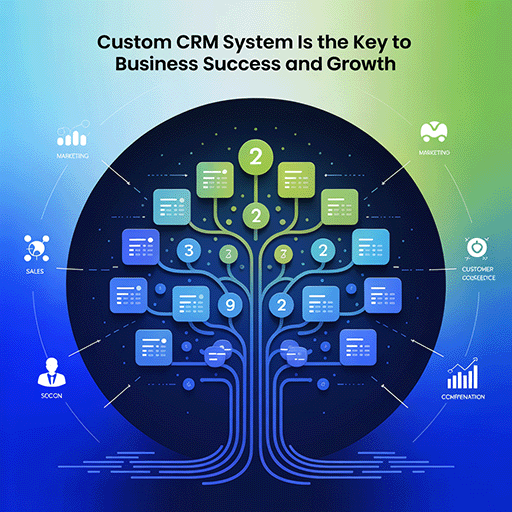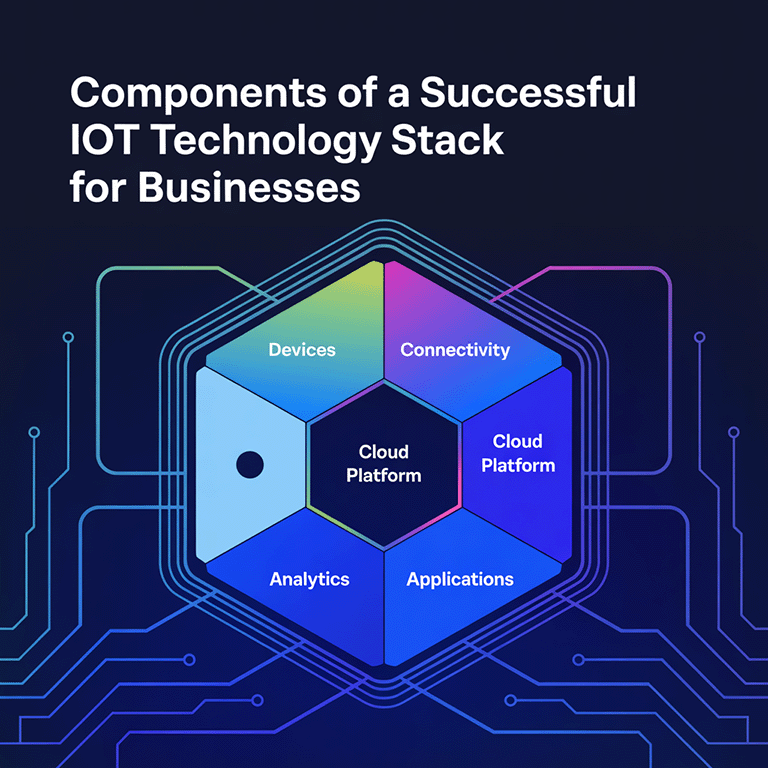Artificial intelligence has become a key component of clinical decision-making, operations, and patient care, according to 2025 AI in healthcare statistics. Deloitte’s Health Care Outlook states that 80% of hospitals now use AI to improve patient care and operational efficiency. AI is being used more and more for patient engagement, administrative work, triage, and diagnosis in both large hospital systems and rural clinics.
In this article, we’ll break down the current status of AI in healthcare, examine the AI in healthcare market size, identify illustrative trends using an AI in healthcare graph, and look into the larger statistics of AI in healthcare that are spurring innovation.
The Current Status of AI in Healthcare
AI is currently being rapidly implemented and widely adopted in the healthcare industry. 46% of US healthcare organisations are in the early phases of implementing Generative AI. AI tools like image analysis, predictive analytics, and NLP-driven transcription are now used in the daily operations of a sizable majority of hospitals. AI-assisted decision support systems are being used by doctors and nurses more and more to expedite workflows and lower errors. Administrative departments are using AI for everything from scheduling patients to processing claims.
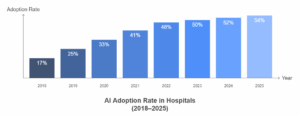
In 2025, clinical departments have successfully incorporated AI solutions, providing:
- Real-time imaging analysis to aid radiologists
- Automated patient intake via virtual assistants
- Intelligent monitoring for high-risk patients
- Data-driven support for policy and decision-making
This indicates a move from experimental to operational use and an increase in confidence in medical devices driven by AI.
AI in Healthcare Market Size & Growth
The AI in the healthcare market size is still expanding. The global market is expected to reach $431.05 billion by 2032. The majority of this value is directed towards treatment planning systems, remote monitoring platforms, and diagnostic tools. Both the financial returns and the clinical benefits experienced during deployment are reflected in the increasing investments, particularly in North America and Western Europe.
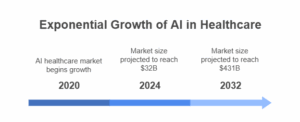
The momentum is notable:
- Health systems invest in AI not just for its clinical potential, but also for its operational efficiency
- Private equity influx into AI-focused health-tech startups accelerates adoption
- Governments and public institutions launch AI-friendly regulations, encouraging broader acceptance
The importance of AI as a fundamental component of healthcare modernisation is highlighted by this growing market.
Visualizing Trends: An AI in Healthcare Graph
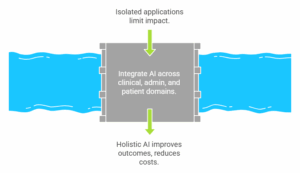
The general trend towards intelligent healthcare is reflected in the following trends, which are based on several industry analyses:
- These days, clinical AI deployments are frequently utilised for report summarisation, imaging, and diagnostics.
- Revenue cycle management systems and other administrative AI provide significant cost savings.
- Tools for patient engagement, such as remote monitoring applications and conversational assistants, improve accessibility and lower readmission rates.
These changes demonstrate the vertical maturity of AI applications across the operational, clinical, and patient-facing domains.
Key Trends and Use Cases in 2025
Diagnostic Intelligence
Hospitals and diagnostic facilities now frequently use AI-powered systems to analyse pathology or imaging slides. These cutting-edge technologies quickly process thousands of photos using computer vision and deep learning to spot minute patterns that the human eye might overlook. They give radiologists and pathologists a valuable second opinion by promptly pre-screening cases, identifying possible abnormalities, and providing quantitative evaluations, such as tumour size, location, or density.
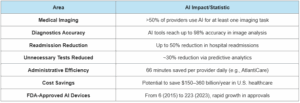
These systems not only expedite workflows but also improve clinical precision by lowering errors caused by fatigue and facilitating more consistent interpretations across high patient volumes. Additionally, they help prioritise urgent cases so that patients with the most important findings are examined first. As a result, physicians enhance patient outcomes and treatment planning in addition to increasing diagnostic accuracy. The increasing use of these tools signals a change to a more effective, data-driven diagnostic procedure that improves healthcare delivery speed and safety.
AI-Powered Medical Records
These days, NLP-based AI systems compile medical records, identify important insights, and recommend courses of action. By drastically lowering the paperwork load, these systems free up healthcare providers to concentrate more on patient care and less on administrative duties.
Predictive Analytics
Predictive models are being used by hospitals more and more to improve clinical care and operational effectiveness. For example, 25% of U.S. hospitals use predictive analytics now.
Large volumes of historical and current data, including patient demographics, medical histories, lab results, and environmental factors, are analysed by these AI-driven tools to predict important events like patient decline, readmission risks, and future staffing needs. These models allow medical professionals to foresee issues before they occur by spotting trends and risk factors early.
Predictive analytics, for instance, can notify physicians of subtle respiratory failure or sepsis warning signs hours before symptoms become clinically evident, enabling prompt interventions that may save lives. In a similar vein, hospitals can create focused post-discharge plans to enhance results and lower penalties by identifying which patients are most likely to require readmission.
On the operational side, administrators can balance workloads, prevent bottlenecks, and guarantee the provision of high-quality care by forecasting patient volumes and staff requirements. These realisations enable healthcare systems to shift from a reactive to a more strategic and proactive approach.
Virtual Health Assistants
AI-driven solutions, such as voice-activated triage assistants and chatbots for appointment scheduling, are enhancing access and cutting wait times while helping patients outside of hospitals.
Comparing the accuracy and sensitivity of AI and doctors in medical imaging
| Detection Task | AI (%) |
Human Experts (%)
|
| Lung Nodule Detection | 94 | 65 |
| Breast Cancer Detection | 90 | 78 |
Operational Automation
These days, AI systems automate operations scheduling, billing, and claims adjudication. Institutions can increase productivity and reduce administrative expenses without sacrificing the quality of care by incorporating intelligent workflows. Hospitals report ROI of $3.20 for every $1 spent, often within 14 months of implementation.
Artificial Intelligence in Healthcare: Broader Metrics
Artificial intelligence in healthcare statistics indicates a consistent rise in the use of AI in clinics and health systems:
- The majority of hospitals now integrate at least one AI-powered system
- Healthcare institutions report noticeable improvements in patient flow and reduced clinician burnout
- Startups focused on AI-driven health solutions attract record-breaking investments

Additionally, integration initiatives prioritise unified workflows over standalone tools, improving patient-care ecosystems as a whole. Approximately 92% of healthcare leaders believe automation addresses staffing shortages.
Challenges on the Road Ahead
Today, the use of AI in healthcare still faces significant obstacles, despite significant advancements. Over 10% of healthcare professionals in the U.S. use AI, and nearly 50% plan to use it in the future. Bias and fairness are two main issues; not all models function equally well across a range of patient populations, and resolving this problem calls for thorough testing and assessment. The skills of the workforce present another difficulty, since many medical professionals require specialised training to successfully integrate AI tools into their daily tasks. Obstacles to data integration also exist; electronic health record systems frequently continue to be isolated and have irregular formats, which prevent smooth interoperability.
Furthermore, regulatory compliance is a continuous concern, necessitating ongoing attention due to changing standards regarding clinical safety, algorithmic transparency, and data privacy. The ethical, efficient, and fair application of AI technologies in contemporary healthcare depends on overcoming these obstacles.
Why These Metrics Matter to You
It is important to comprehend these AI in healthcare statistics for several reasons:
- Making strategic decisions: Understanding the obstacles and best practices is necessary for investing in successful AI solutions.
- Patient outcomes: AI can improve diagnosis speed and accuracy, ultimately saving lives.
- Operational performance: Automation facilitates resource management, billing, and staffing.
- Innovation readiness: Organisations that use AI now create the framework for personalised medicine in the future.
To optimise benefits, healthcare leaders must match the adoption of technology with organisational objectives and clinical evidence. 40% of U.S. physicians are ready to use generative AI when interacting with patients at the point-of-care.
Real-World Example: AI Improves Patient Triage
In late 2024, a mid-sized American hospital integrated an AI triage solution with its electronic health record (EHR) system. The system, which was first implemented during periods of high traffic, analysed patient symptoms, medical history, and real-time vitals using predictive algorithms. By correctly identifying high-risk patients, it allowed clinical staff to prioritise care and drastically cut down on wait times in emergency rooms. In addition to improving patient outcomes, this also lessened staff burnout during busy times.
The hospital broadened the scope of the solution by early 2025 to include chronic disease monitoring for ailments like COPD, diabetes, and heart failure. The AI identified warning signs before they became emergencies by continuously analysing patient data from wearables and home monitoring devices. By taking a proactive stance, doctors were able to help patients better manage their conditions at home and intervene earlier. As a result, the hospital experienced better continuity of care, a quantifiable decrease in preventable hospitalisations, and more effective departmental resource allocation.
How LITSLINK Supports Healthcare AI
We guide healthcare organisations through the responsible deployment of AI as part of our AI integration services. We help care providers improve outcomes and streamline operations by providing safe, scalable software solutions, like virtual assistant systems, medical image analysis pipelines, and NLP summarisation tools.
Explore more in our Healthcare Software Solutions or discover our full AI development services designed for regulated industries.
Final Thoughts
The comprehensive 2025 AI in healthcare statistics show that AI integration is already well underway and is speeding up. Clear clinical outcomes and administrative advantages are what motivate adoption. However, proactive attention is required in challenging areas such as interoperability and bias.
Working with a competent development team is crucial if you’re creating AI-powered healthcare solutions or trying to update clinical workflows.
Fortunately, we have extensive experience with safe software integration and AI platforms of the highest calibre for healthcare. We can also do that for you. Let’s begin by getting in touch with us!


